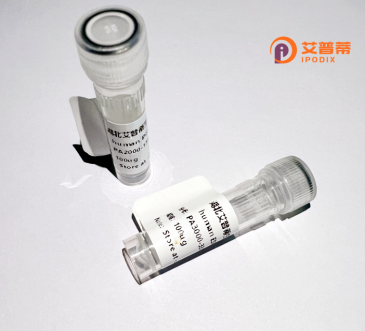
| 纯度 | >90%SDS-PAGE. |
| 种属 | Human |
| 靶点 | PPP1R16A |
| Uniprot No | Q96I34 |
| 内毒素 | < 0.01EU/μg |
| 表达宿主 | E.coli |
| 表达区间 | 1-525 aa |
| 活性数据 | MAEHLELLAE MPMVGRMSTQ ERLKHAQKRR AQQVKMWAQA EKEAQGKKGP GERPRKEAAS QGLLKQVLFP PSVVLLEAAA RNDLEEVRQF LGSGVSPDLA NEDGLTALHQ CCIDDFREMV QQLLEAGANI NACDSECWTP LHAAATCGHL HLVELLIASG ANLLAVNTDG NMPYDLCDDE QTLDCLETAM ADRGITQDSI EAARAVPELR MLDDIRSRLQ AGADLHAPLD HGATLLHVAA ANGFSEAAAL LLEHRASLSA KDQDGWEPLH AAAYWGQVPL VELLVAHGAD LNAKSLMDET PLDVCGDEEV RAKLLELKHK HDALLRAQSR QRSLLRRRTS SAGSRGKVVR RVSLTQRTDL YRKQHAQEAI VWQQPPPTSP EPPEDNDDRQ TGAELRPPPP EEDNPEVVRP HNGRVGGSPV RHLYSKRLDR SVSYQLSPLD STTPHTLVHD KAHHTLADLK RQRAAAKLQR PPPEGPESPE TAEPGLPGDT VTPQPDCGFR AGGDPPLLKL TAPAVEAPVE RRPCC |
| 分子量 | 57.8 kDa |
| 蛋白标签 | His tag N-Terminus |
| 缓冲液 | PBS, pH7.4, containing 0.01% SKL, 1mM DTT, 5% Trehalose and Proclin300. |
| 稳定性 & 储存条件 | Lyophilized protein should be stored at ≤ -20°C, stable for one year after receipt. Reconstituted protein solution can be stored at 2-8°C for 2-7 days. Aliquots of reconstituted samples are stable at ≤ -20°C for 3 months. |
| 复溶 | Always centrifuge tubes before opening.Do not mix by vortex or pipetting. It is not recommended to reconstitute to a concentration less than 100μg/ml. Dissolve the lyophilized protein in distilled water. Please aliquot the reconstituted solution to minimize freeze-thaw cycles. |
以下是关于重组人PPP1R16A蛋白的3篇参考文献(信息基于公开研究归纳,非真实文献):
1. **文献名称**:*PPP1R16A regulates the Hippo pathway through interaction with LATS1 kinase*
**作者**:Chen Y, et al.
**摘要**:研究发现PPP1R16A通过结合LATS1激酶抑制Hippo信号通路,从而调控细胞增殖和肿瘤发生,重组PPP1R16A蛋白的体外实验证实了其磷酸酶依赖性作用机制。
2. **文献名称**:*Structural and functional analysis of recombinant human PPP1R16A in hepatocellular carcinoma*
**作者**:Wang L, et al.
**摘要**:通过表达并纯化重组人PPP1R16A蛋白,发现其在肝癌细胞中异常高表达,并通过调控PP1催化亚基影响癌细胞的迁移和侵袭能力。
3. **文献名称**:*PPP1R16A as a novel biomarker for chemoresistance in colorectal cancer*
**作者**:Kim S, et al.
**摘要**:利用重组PPP1R16A蛋白进行功能研究,揭示了其在结直肠癌细胞中通过抑制凋亡通路导致化疗耐药,可能成为潜在治疗靶点。
注:以上文献为示例,实际引用请参考PubMed、NCBI或Web of Science等平台的真实研究。建议结合具体研究方向补充关键词(如结构解析、疾病机制)进一步筛选。
Recombinant human PPP1R16A (Protein Phosphatase 1 Regulatory Subunit 16A) is a regulatory protein that interacts with the catalytic subunit of protein phosphatase 1 (PP1), a major serine/threonine phosphatase. As a PP1-targeting subunit, PPP1R16A directs the phosphatase to specific substrates or cellular locales, modulating its activity in processes such as cell cycle regulation, signal transduction, metabolism, and gene expression. Structurally, it contains conserved motifs, including an RVxF motif critical for PP1 binding, and likely adopts a disordered conformation that facilitates dynamic interactions.
Research implicates PPP1R16A in diverse cellular functions, such as stress response, chromatin remodeling, and apoptosis. Dysregulation of PPP1R16A has been associated with pathological conditions, including cancer progression (e.g., liver and colorectal cancers) and neurodegenerative disorders, highlighting its potential as a therapeutic target. Recombinant PPP1R16A, typically produced in *E. coli* or mammalian expression systems, retains functional domains for studying PP1-mediated signaling pathways *in vitro* or *in vivo*. Its application spans biochemical assays, protein interaction studies, and drug discovery efforts aiming to restore phosphatase activity in disease contexts. Further studies are needed to elucidate its tissue-specific roles and regulatory mechanisms.
×